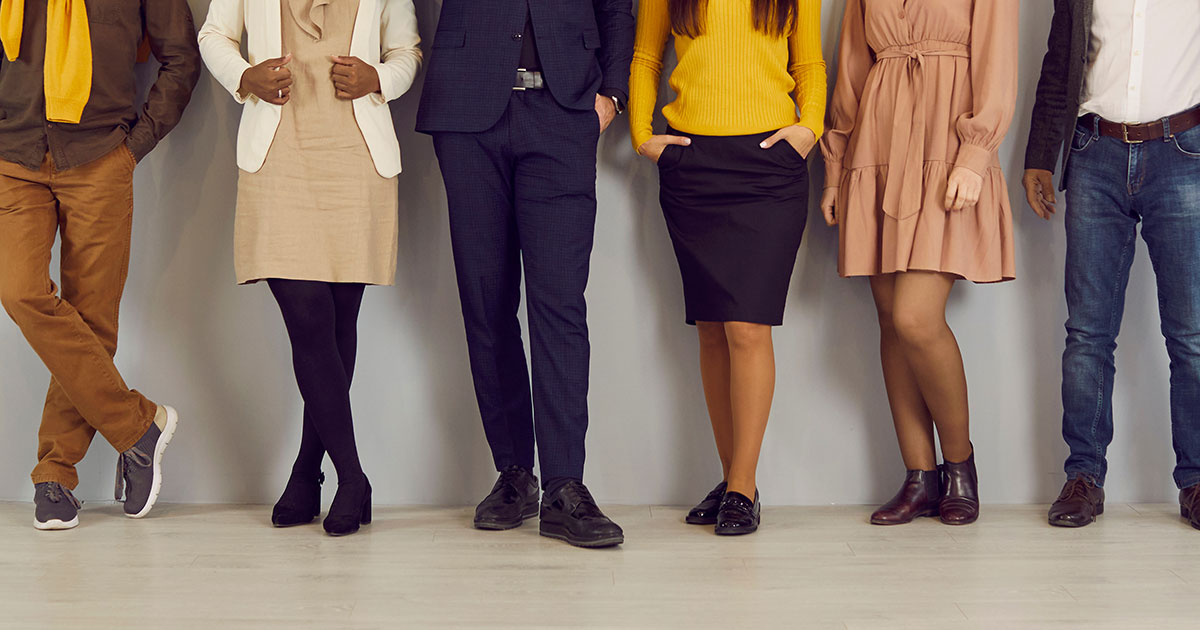The Office Dress Code: What Has Changed, and What Has Not?

What should I wear to the office today?
That question, in this time of increased remote work, can be a tricky one. On the one hand, the office dress code feels in flux, upended by the pandemic and a host of other lasting cultural shifts. A number of workplaces now seem to be accepting of more casual, comfortable attire.
On the other hand, the workplace still has norms of dress and behavior. Looking your best remains important. If you want to appear capable, especially if you’re new to a job, you need to pay attention to how you dress. “First impressions aren’t fair, but they are powerful,” says Emily Rosado-Solomon, a Babson College assistant professor of organizational behavior, whose research looks at the workplace. “If you look the part, you seem more competent and professional.”
For all these reasons, figuring out what’s appropriate dress for work is not a clear-cut decision. Rather, it’s a balance, between dressing casually and dressing professionally, between standing out and fitting in, between following your own style and following the traditional style of the workplace. “It’s a tightrope we all walk, especially early in a career,” Rosado-Solomon says. “Succeeding in the workplace is a mix of authenticity and conformity.”
That brings us back to that critical question: What should I wear to the office today? To answer that, Rosado-Solomon takes us into today’s workplace and the forces shaping its culture.
Broadly speaking, the office dress code has loosened up in recent years. “In general, we see it is slightly less formal,” Rosado-Solomon says. That said, every industry has different expectations, and even companies within industries can be wildly different in their office dress codes.
When employees step into a new office, Rosado-Solomon advises them to take a good look around at people’s outfits. “Are they wearing khakis? Are they wearing blazers? Are they wearing ties?” she says.
If you’re hoping to one day advance in your career, especially take note of what the supervisors are wearing. “Dress for the job you want is true in a lot of ways,” Rosado-Solomon says.
Ultimately, if you have no idea how to dress, err on the side of being more formal. Yes, you risk sticking out, but the message you send with your clothes is one of professionalism and effort. “What you’re signaling is I’m trying really hard here,” Rosado-Solomon says.
Not Everything Has Changed

The office dress code may have become a bit more casual, but some things haven’t changed.
Rosado-Solomon teaches a course called Career Launch: Internship Experience Lab, which offers guidance and reflection to students doing an internship. Part of that course discusses clothes and professionalism, and Rosado-Solomon asks students to find pictures that exemplify what a typical outfit looks like in their workplace.
Taken together, those pictures offer a mostly colorless portrait of office attire, showing outfits that are black, white, and gray. Blue is the only color that regularly pops up. “There is a limited color palette,” Rosado-Solomon says. “I was surprised by the consistency of what was there.”
That drab color palette shows that traditional aspects of the office dress code—think men in white and blue shirts working in finance and corporate environments—still holds sway.
Office Dress Code Shifts
While the pandemic and the explosion of remote work that followed in its wake is a big reason for the changing work wardrobe, it is far from the only one, Rosado-Solomon says. There are various cultural shifts in play.
In the office, organizations have had greater appreciation and acknowledgement of mental health (employees often feel less stress if they can showcase part of their personality at work); of diversity, equity, and inclusion (The CROWN Act, which is law in 26 states, prohibits race-based hair discrimination in schools and workplaces); and of body positivity (employees feel more confident when they can wear clothes that properly fit their body type).
Taken together, these movements allow workers to feel like they can bring more of their true selves to the workplace. “You don’t want to hide yourself at work,” Rosado-Solomon says. “We are seeing a need for some authenticity in the workplace.”
“It’s a tightrope we all walk, especially early in a career. Succeeding in the workplace is a mix of authenticity and conformity.”
Emily Rosado-Solomon, assistant professor of organizational behavior
Strategically Authentic
Rosado-Solomon applauds the changing office dress code. To dress less formally, she says, costs less. Buying suits for work is pricey, so much so that Babson has set up a fund to help pay for students’ professional attire. “These things are very expensive,” she says. “That presents an extra hurdle for those from a lower socio-economic status.”
Being authentic in the workplace, though, does come with limits. One might feel their best in jeans and a sweatshirt, for instance, but that won’t obviously do when working in finance. “We want to be authentic, but we don’t want to be unfiltered,” Rosado-Solomon says. “If you want to look the part, there are still certain unspoken norms of what that looks like.”
When considering what is appropriate dress for work, employees can give a hint of their authentic selves in small ways, through jewelry, a hairstyle, or wearing a splash of color. “There are a lot of ways to be strategically authentic,” Rosado-Solomon says.
Posted in Insights





